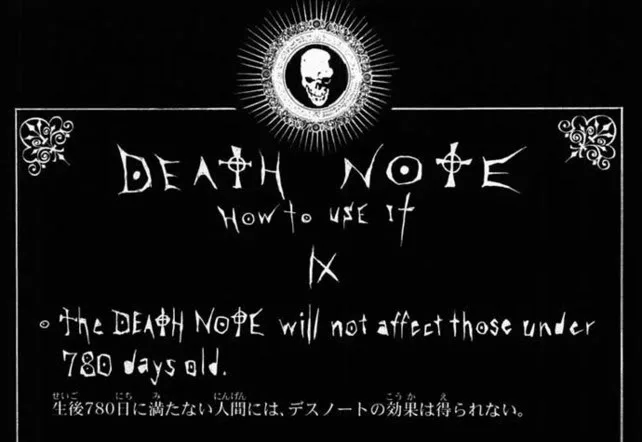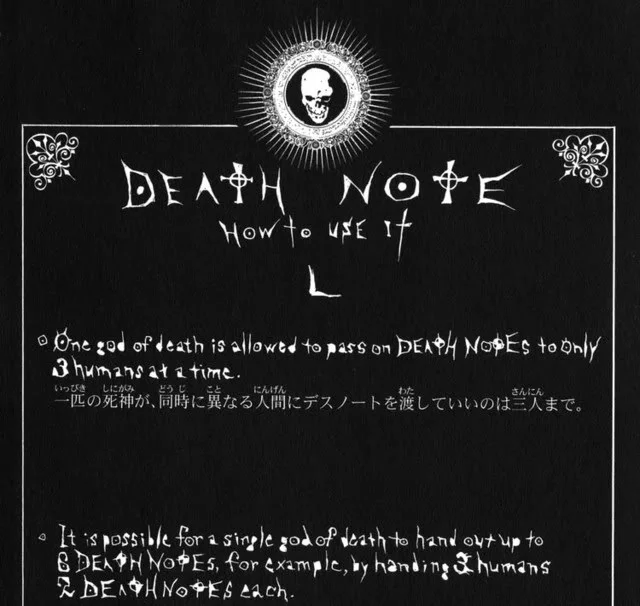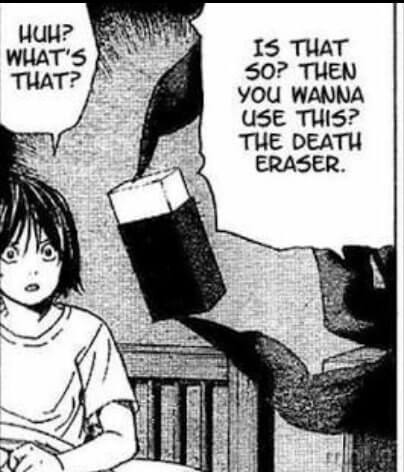The basic rules of the manga/anime death note are well-known to most fans and you can read them in our previews article death note rules.
Some of these rules are not included in the main series, which creates some fascinating lore that many fans don’t know about.
What other Death Note rules are you curious about?
These are ten Death Note rules that manga-only fans probably have never heard of.
Spoilers ahead.
1. Age Limitations

Specified in: Chapter 13: Countdown, Chapter 36: Father and Son, Chapter 41: Matsuda
- Children under 780 days of age will not be affected by the Death Note.
- A child younger than 6 years old based on the human calendar must not receive the Death Note from the god of death (Shinigami).
- The Death Note cannot be used to kill people over the age of 124.
These are some fascinating rules about age.
You’re protected from Death Notes up to age two, or beyond 124.
Not very comforting.
Shinigami can’t give Death Notes to children under six years of age; however, another rule states that notebooks can still be used, regardless of age. Yikes.
2. Names that are misspelled

As previously stated in Chapter 13: Countdown and Chapter 49: Potted Plant
- If the victim’s name is mispelled four times, the Death Note will not work.
- A Death Note owner who accidentally misspells four names will not be killed if they do so. The Death Note owner who intentionally misspells the name four times will be killed.
- A Death Note will not allow the person whose name has been misspelt four more times to be exempted from death.
These are some of the most confusing rules.
Here’s my take. You can’t use the Death Note if you misspell a name more than four times accidentally.
If you deliberately do this, it will cause you to die.
Even if you misspell a name four more times, the victim is not permanently immune to Death Note.
If their name is finally correct, they would die as normal.
These rules were probably created to stop people from trying to protect others.
Misspelling someone’s name won’t indefinitely protect them.
And even if it did, it would be fatal.
3. Attempting to Enter a Name More Than Once

As mentioned in Chapter 25, “Fool”
- If the same name appears on more than one Death Note, the first one filled in will be effective regardless of the death date.
- If the writing of the same name on two Death Notes takes less than 0.06 seconds, it will be considered simultaneous. The Death Note will not have any effect and the person who wrote it will not die.
These rules are not used in the main series.
However, the first one is used in live-action Japanese films (specifically The Last Name).
Detective L deliberately writes his name so that he can die as far in the future as the Death Note allows (23 Days), to prevent Kira from killing him.
Aside note: I think the first rule is poorly stated. It cites an example of a name written on more than three notes.
However, I believe that the intention is to simply explain what happens if a name has been written on more than one note.
4. Breaking the 23-Day Rule

As mentioned in Chapter 40: Allies
If you write “die from disease” after a specific disease name but without a time limit, the 23-day rule will not apply. Humans will still die in accordance with the disease.
The Death Note normally allows you to cause someone’s death for up to 23 days into the future.
The above rule allows you to kill someone with a long-term illness, but it does not allow for this exception.
An earlier rule stated that the disease must progress over a period of time, meaning it is difficult to kill someone with diseases right away.
One side effect of the 23-day rule is that Death Note users cannot control a victim’s actions for more than 23 days.
However, I wonder if this loophole could allow them to be used for longer. This is not clear.
5. Impossibility of Changing Immediate Deaths

As mentioned in Chapter 41: Matsuda
Humans cannot be killed if they have less than 12 minutes left to live in their human calculations.
This tidbit stops notebook users from removing people with less than 12 hours of life remaining. This seems to be a rare issue. If someone is about to die, then you don’t have to manually kill them.
But, Death Note users can only trade half of their life for Shinigami eyes, so it is possible, but unlikely, that a plan fails based on this rule.
Take Light Yagami’s encounter with Naomi Misora.
If her name-writing had failed, and she still had 12 minutes to live, she could have used those extra minutes to tell someone about Kira’s identity. (Light revealed his identity to her after he wrote her name).
6. Shinigami Killing Boundaries

As mentioned in Chapter 48, GiveandTake
- A god of death living in the world where the Death Note is held can not kill the owner of the Death Note.
- A god of death, who arrives in the human world to kill the Death Note owner, will also not be able.
- Only a god or goddess of death can kill their Death Note owner.
Shinigami can live with death without injury or Death Notes, which is a major advantage over humans.
However, even the gods are limited in their use of Death Notes.
The above rules explain that only those Shinigami who have already entered the human world can kill Death Noteholders, and only if they weren’t destined to do so.
7. Shinigami Reproduction

As Mentioned in Chapter 52: Split-Second
Although there are male and female gods that die, it is not allowed or possible for them to have sexual relations.
Also, the gods of Death can not have sex together.
This rule states that Shinigami cannot mate with humans, or each other, despite their gender.
It is not known how they came to be.
The Death Note wiki notes that Shinigami might still have emotions related to the opposite sex, so they can still romance each other.
8. Shinigami Administration

As Mentioned in: Chapter 70: Tremble
The world of gods is bound by laws.
There are nine levels of severity for gods of death who break the law.
Level 8 is the most severe and Level 1 is the extreme level.
After being punished for any severity above 3, the god of death is likely to be executed.
The Extreme Level is, for example, when a person kills another without using the Death Note.
Although we don’t know much about Shinigami society and its laws and punishments, this article will tell you about them.
Shinigami cannot kill people without using Death Notes, and they can also die if they use Death Notes to prolong a person’s life, which is against their nature.
Although the rule states that they can be executed if they break a rule, details about how this execution takes place are not available.
Shinigami, at least, are invulnerable to physical attacks by humans.
9. 6-Notebook Limit

As stated in How to Use It: XLIX and How to Use It: L
- In the human world, no more than six Death Notes can be used at once in the death of a person. The Death Note, which the god of death holds, does not count. Only 6 gods of the dead that have passed on their Death Notes to humans can remain in the human world.
- Only 3 people can receive Death Notes from a single god of death at a given time.
- A single god of death can hand out 6 Death Notes. For example, he could hand 3 people 2 Death Notes each.
- Also, one person could have all six Death Notes.
Six is a common number in the Death Note rules. For example, you can only change the details of a death every six minutes and forty seconds.
This number represents the total number of Death Notes that are allowed in the human world.
It does not include the Shinigami notebooks.
A seventh notebook is rendered inoperable if it appears before one of the other Death Notes is destroyed or returned to the Shinigami realm.
10. Memory-Regaining Limits

As Mentioned in: Chapter 54: Inside
- When you lose ownership of the Death Note, your memory will be lost. You can either get your ownership back or touch the Death Note to regain your memory. This can be done up to 6 times per Death Note.
- If the six-time limit is exceeded, the Death Note’s memory will be lost and the person will have to use it again without any prior memory.
Light, in the main series, erases his memories by forgoing ownership.
He casts suspicion on himself and eventually takes back his notebook.
Kira then resumes her activities.
This is a clever strategy, but users can only cycle ownership or memories up to six times.
Although you can do more, you can not regain previous Death Note-related memories.
It’s unlikely that someone would lose their ownership so much.
11. Death Eraser

Today’s clarifications are in addition to the original Death Note plan that included a “Death Eraser” which allows you to save a person’s name (before they die).
Similar power is available in Netflix’s death note movie, where you can save the life of a victim by burning their pages.
These are in contrast to the main manga and anime, where you can change details about the death, but not the actual death.
Although the rules can be modified across media (e.g. Netflix allows users to control victims for only two days), the notebook is still a reliable tool or, as Near would put it, a weapon.
As we wait for more notebook clarifications, please share your thoughts about the Death Note.
I’ll be there at our next anime countdown!